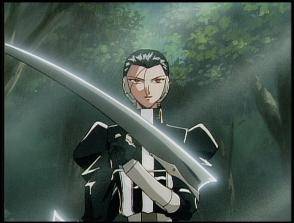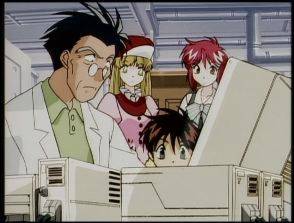|
Twin
Signal, first released in 1996, has finally seen the
light of day over on these shores with MVM's vanilla-flavoured
Region 2 release. This DVD features all three episodes of
this OVA, which is based on the manga by Sachi Oshimizu.
Plotwise,
Twin Signal is as simple as you can get.
Dr. Otoi, a world-renowned robotics expert, creates a state-of-the-art
robot to act as a "big brother" for his grandson Nobuhiko.
He names this robot Signal. Unfortunately, due to a mishap
during Signal's programming, whenever Nobuhiko sneezes,
Signal transforms into a child-like, playful version of
himself – much to his chagrin, as he's meant to be
a high-powered combat robot. In these three episodes, Dr.
Otoi's arch-rival steals Signal's predecessor, Pulse, and
reprograms it to seek out and destroy Signal. Of course,
thanks to Twin Signal's colourful cast of characters – and
the style of the story, which I'll talk about later – things
don't go exactly to plan.

Even
though Twin Signal appears on the surface
to be an action-packed, explosive combat fest, the reality
is very different. First of all, the plot is laced with
slapstick comedy; running gags include heavy bookcases falling
over, two bumbling henchmen – one big, one small, and of
course the little one's the older brother – random penguins
that aren't given any explanation whatsoever, and a cute
female robot with a tendency to break every dish in the
house. Secondly, the script is juvenile at best – there's
no real complexity to the story, which seems designed only
to connect one slapstick scene to another. Even the action
is half-hearted at best.
But
I digress; that's not the point. Twin Signal isn't trying to be a serious animé, it knows precisely
what it is. Some of the comedy moments involve spoofing
several animé clichés (something that fans
of Excel Saga may be familiar with) – Signal has
a habit of making unnecessary grand entrances whenever he
transforms back to normal; his rival Pulse is near-sighted
and makes his evil threats to a nearby tree; the main villain
is hidden in darkness for the first half of the story, a
la Inspector Gadget's Dr. Claw, but is revealed to
be a decrepit old man surrounded by junk when someone unwittingly
opens the curtains. An animé like this is a breath
of fresh air after so many "serious" shows; I haven't sniggered
this much since I saw Dragon Half (which covers mostly
the same ground).
The
series' animation bears a slight roughness that is commonplace
with mid-90s animé – as a whole, the style reminds
me of the early episodes of Pokémon. Action
sequences are over-the-top, but all of the fighting characters
move swiftly and smoothly. Characters have a habit of suddenly
switching to "chibi" mode when they don't need to be so
serious, with out-of-proportion bodies and facial features
– a hallmark of this type of story. Probably the best-animated
sequence in the series is the opening credits, but then
that's to be expected; credits sequences are often better
animated than the series they accompany.

Soundwise,
the incidental score can only be described as "whacky",
and it fits neatly with the ethic of the series. Half of
the impact of slapstick comedy comes from the music that
accompanies it, after all. However, I do have a bone to
pick with whoever wrote the opening theme – it's too serious
and dynamic for such a light-hearted series. The English
voices are so-so, often prone to overacting – I suppose
if we're not meant to take this show seriously, neither
should they!
Twin
Signal, overall, is something you'd rent from a video
store if you need something to keep pre-teens happy for
an hour and a half. It's clearly not designed for an adult,
critical eye, and especially not one who's used to more
serious endeavours. If you're looking for something to watch
with kids, or as a family, you could do worse than Twin
Signal; it's simple, inoffensive and entertaining.
The
picture is framed at its original 4:3 and is an NTSC to
PAL transfer, but a good one – detail, sharpness and colour
are all very good, though there is some occasional blurring
on fast movement.
Both
Japanese and English soundtracks are available. Both feature
reasonable stereo separation on music and some sound effects
and are clear and well produced.
The
optional English subtitles are bright yellow and easy to
read.
Not
much in the way of features for Twin Signal
– some mildly-amusing Outtakes from the
English voice cast, an Art Gallery and trailers
for Ranma 1/2, Trigun and R.O.D.
|